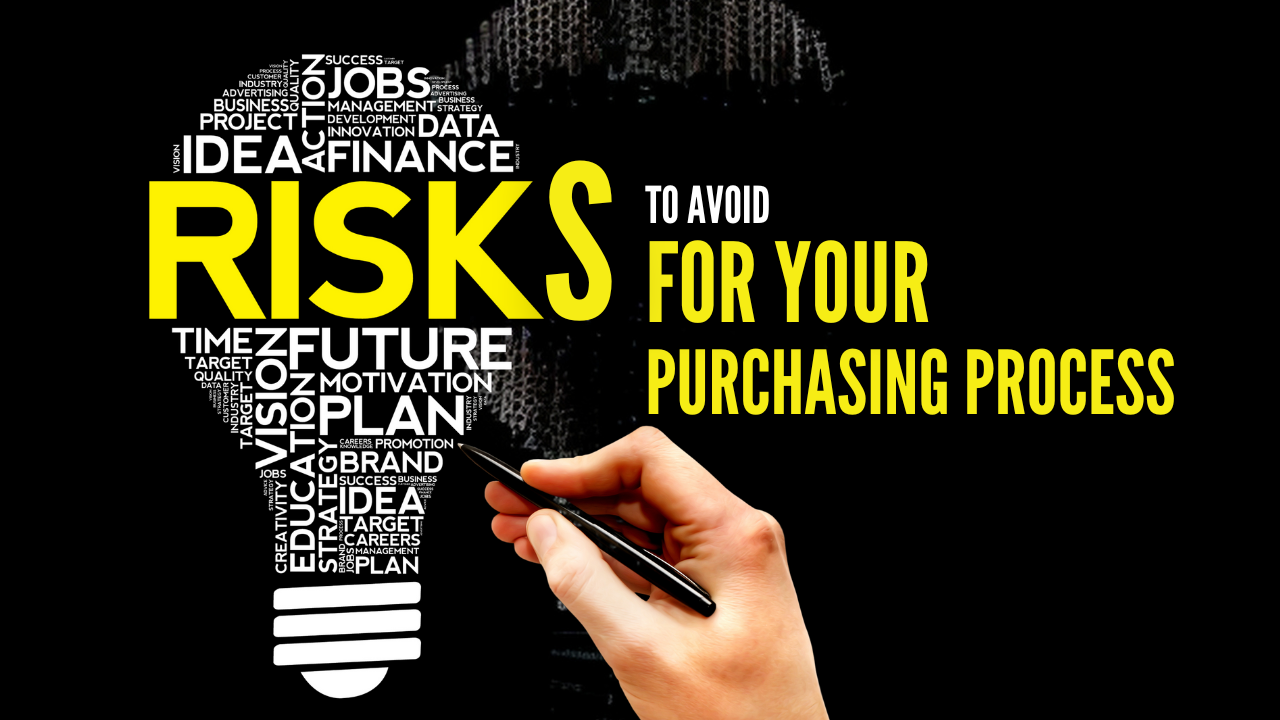
Within a company, purchases are closely linked to risks. Indeed, behind the procurement of a service or product lie numerous issues that constitute the primary tasks of a purchaser. Consequently, poor procurement management amplifies risks that affect productivity and thus directly influence your company’s progression. It is therefore crucial to identify, assess, and anticipate their impact on the company’s strategic objectives in order to effectively control them.
What is the purchasing process?
The procurement process refers to the acquisition of goods or services from an external source, typically known as a supplier. Its purpose is to identify the need for a product or service, find and evaluate potential suppliers, negotiate terms and conditions, and finalize contracts upon agreement.
In essence, procurement management aims to obtain the best goods or services possible under the most favorable conditions for a company’s benefit, ensuring its smooth and optimal operation.
A company’s procurement process generally involves several stages, among the most crucial are:
- Needs Definition: Defining the requirements and specifications of the product or service needed by the company. This stage is crucial and significantly influences the subsequent procedure.
- Supplier Selection: Researching and evaluating potential suppliers, examining their references, credibility, financial stability, and production/delivery capacities.
- Negotiation: Involves negotiating important terms such as price, delivery schedules, and performance guarantees.
- Contract Award: Finalizing the contract with the selected supplier.
- Contract Management: Monitoring the supplier’s performance and managing the contract.
What Risks Does the Purchaser Face?
There are four major families of risks associated with purchasing: financial, contractual, operational, and image-related risks (CSR theme). The maturity of procurement increases the risks borne by the purchaser and the company. It’s essential to identify these risk categories as early as possible to better anticipate them and facilitate the steady growth of your business. Indeed, it is never too early to steer your purchases in the right direction.
Strategic and Financial Risks
Efficient procurement management equates to sound expense management. Financial risks are the most visible and critical as they represent the company’s financial health. Several indicators can help assess this and alert you to the adequacy of your purchasing process. Here are a few:
- Supplier dependency rate: The higher it is, the more risk you take. If a supplier fails or doubles its prices, your production or sales processes will be significantly affected. To mitigate this risk, identify new suppliers and diversify your sources.
- Operating Income (Quick accounting parenthesis): Higher purchasing costs result in lower operating income. Thus, maintaining a high operating income is crucial. A low operating income decreases your margins and exhausts resources in an endless search for new customers to maintain results.
- Supplier payment delays: This might align with your business cash flow strategy, but it often results from a lack of provisions or foresight. Plan your purchases in advance or improve purchase tracking to provide timely information to your financial services.
Each indicator may have varying degrees of impact on the company’s financial health. Therefore, remain vigilant and make intelligent purchasing decisions by implementing supplier contracts, among other strategies.
Contractual and Legal Risks
Effectively negotiating a contract is a prerequisite in the procurement function. However, before diving into major negotiations, it’s crucial to understand contractual risks! Here are various points to focus on to be sufficiently prepared to address these risks:
- Fraud: Some suppliers may be fictitious or exercise their function illegitimately. Certain professions are subject to regulation, so ensure compliance with accreditations or standards that govern these professions.
- Abusive termination or abrupt contract interruption: Incorporate a notice period into the contract to enable recovery in case of such scenarios.
- Absence of Liability/Decennial: Insurance of a supplier leading to the non-coverage of a loss.
- Automatic renewal: Some suppliers leverage automatic contract renewal to extend engagements, often to their advantage.
This necessitates a good understanding of your supplier’s situation and your company’s stance towards them. Vigilance should focus on your business processes to limit the emergence of risks.
Operational Risks
The procurement process is susceptible to business or technical risks. Thus, each stage of the process exposes you to a risk. The following list is not exhaustive, but it provides a good foundation for anticipating these risks within your company.
- Purchase not meeting the company’s needs: If the specifications were poorly defined during the expression of your need, receiving the wrong part or service should not come as a surprise.
- Duplicate orders: imply duplicated expenses or a strained situation with your supplier who has initiated production or delivery of the ordered service. Communicate!
- A prolonged invoice reconciliation (or worse, the loss of an invoice) shouldn’t waste unnecessary time. Keep track of your purchases from the issuance of the purchase order until the receipt of the invoice. This has the advantage of providing a lead time for your accounting department to provision your expenses.
- The absence or inadequate definition of supplier pre-selection criteria: Sometimes, the added value of a purchase lies in selecting the right supplier. Don’t overlook any aspect!
These risks associated with organizational flaws during various stages of the procurement process almost always result in financial losses and a slowdown in productivity. Therefore, audit your business processes to anticipate them, and refine your procurement strategy to be exemplary, even in its image!
Risks to reputation
These risks are related to the ethical, societal, and environmental aspects of your company, commonly known as Corporate Social Responsibility (CSR). It encompasses all business practices aimed at promoting sustainable development, respect for human rights, and social equality.
Even though ensuring CSR strategy isn’t an inherent function of a purchaser, they remain responsible for orders and purchases made on behalf of the company. The company’s image is directly involved, so it falls to the Purchasing department to choose suppliers that align with the company’s commitments. Here are some examples to safeguard against risks to your image:
- Your suppliers’ production or supply chain. Scrutinize it to eliminate those showing negligence in terms of CSR or whose way of working is at odds with yours. You certainly don’t want to be in the spotlight as a company that supports such a supplier.
- Cascade subcontracting. To win contracts, some companies are willing to do anything, including slashing prices and subcontracting the mission. Their subcontractors repeat the operation. Ultimately, your supplier is no longer the one you contracted with, often disregarding labor rights.
- News events. One of your partner companies may unwittingly make headlines. Be alert to this possibility and ready to respond if communication goes against your interests.
Your reputation, especially your online reputation, is at stake. To counter this risk, define your commitments and audit your suppliers so that they evolve in the same direction as yours. Be the change you want to see!
In conclusion, these four major risk categories can threaten all types of companies if not considered by your management. Therefore, you must anticipate and map them to prepare a response if you encounter them. This way, you will save time in resolving them and, at best, save on not having them arise at all.
How to manage risks related to the purchasing process?
Managing risks associated with purchases in a company aims to anticipate and thereby prevent potential problems, with the goal of protecting companies against risks incurred during the ordering process. Every transaction involves many critical points to inspect, including product quality, supplier reliability, customer satisfaction, and the company’s reputation, all of which must be monitored to avoid any issues.
Procurement managers need to explore new technologies and strategies to manage the essential functions of the supply chain. A robust plan for managing risks related to purchases can help your organization save money, avoid unfavorable situations, and operate smoothly and efficiently. Here, we summarize five strategies that can help your organization reduce purchasing-related risks.
Analyzing expenses
An expense analysis reveals what’s happening in your company’s financial management. By precisely analyzing expense data, you can obtain valuable information about your procurement expenses, such as unidentified payments, redundancies, duplicate invoices, irregular expenses (like wild purchases), and identifying important, highly sought-after suppliers with whom new rates could be negotiated.
Examining past expenses can also help you avoid risks like an inadequate analysis of internal needs. For instance, you can understand if your needs are over or underestimated, if you’re operating within a limited timeframe, or if you have an insufficient budget.
Relying solely on a single supplier for essential goods and services poses a significant risk. If they fail to deliver on time, your entire supply chain could be disrupted. Expense analysis can help determine if you’re overspending on certain suppliers or if you’re overly reliant on very few suppliers.
Ensuring transparency in purchasing information
Implementing a transparent purchasing policy can significantly reduce duplicate orders. Furthermore, with better visibility, duplicate requests will be quickly spotted and, consequently, avoided.
When all processes are transparent and available for everyone to see, you can track the history of every transaction, preventing any uncontrolled purchases. The more transparent the processes are regarding those who make or authorize purchases, the more savings and efficiency you can achieve.
It will also be much easier to identify individuals who tend to violate company policies, understand why it happens, and find ways to address identified issues.
Consolidating your supplier panel
Having multiple suppliers for the same product or product range is a challenge, as it’s hard to monitor each of them. If you have fewer suppliers, your organization can focus better on risk prevention, such as price volatility that can affect your company’s financial health.
Through effective supplier consolidation, procurement teams can avoid risks like excessive spending. Your company can get better rates for a product by allocating more products to fewer suppliers. Overall, the cost of freight, handling, and other delivery/transportation fees will also be reduced.
However, it’s worth noting that for products and services essential to your business, you should have more than one supplier. In such cases, it’s better to have multiple suppliers because you’re not dependent on a single supplier who can influence your company’s entire production.
Improving relationships with your suppliers
Maintaining good relationships with suppliers is a significant asset. Effective supplier management helps avoid disruptions in the supply chain, such as delivery delays or poor-quality products. Furthermore, better visibility helps identify and mitigate potential risks.
Further read: 6 tips for optimal stock management
Monitoring and enforcing contracts
Ensuring compliance with contracts is an important area that must be regularly monitored. This indicator will help determine the extent to which suppliers adhere to negotiated conditions, such as delivering quality goods within agreed-upon timelines.
This indicator shows the percentage of contracts that have been fully executed and whether all agreed-upon requirements have been met. Adherence to these requirements improves communication with suppliers, applies non-compliance rules, and ensures quick rectification of issues.
Moreover, focusing on compliance also helps control internal processes and regulate expenses within the company, thereby eliminating excessive spending by internal stakeholders. The higher your compliance rate, the fewer losses your procurement process generates.





